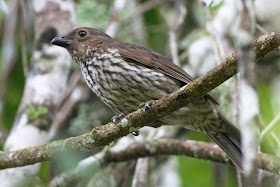Sunday, 3 October 2021
North Queensland Spring 2021 – Part One: The journey north & Atherton Tablelands
We headed up to north Queensland for a month-long sojourn with the central focus being a visit to Iron Range on Cape York. No caravan this time as much of the trip was accommodation-booked. That was handy in some respects but we missed the van. Overnight stops at Mt Larcom and Sarina before Ayr, where the first birding was underway in a fine mix of freshwater wetland and mangroves along Old Wharf Road near the town. Brolga (below) and Black-necked Stork were about.
Of surprise was a grouping of 8 Wood Sandpipers (below) – an unusually large concentration for this species. A few Red-kneed Dotterels and Sharp-tailed Sandpipers were on the wetland.
In the mangroves were Shining Flycatchers (above) and Yellow White-eye (below). The white-eye is inexplicably scarce along the east Queensland coast and indeed this was a state tick for me.
Large-billed Gerygone (below) and Olive-backed Sunbird were common.
We moved on to Ingham and checked out the Tyto Wetlands. A 2.5m Saltwater Crocodile (above) was here; rangers had set a trap with wild pig bait, presumably for this animal. Also about were two big Red-bellied Black Snakes (below) embroiled in what seemed to be territorial fight between males.
Green Pygmy-Goose (above) was common and Northern Fantail (below) put in an appearance.
We moved on to Forrest Beach (below) nearby, a delightful retreat. Mostly we opted for caravan park cabins on this trip, or motel rooms when these were not available. The park here is excellent.
Brown-backed Honeyeaters were attending a nest nearby.
I visited the indigenous-owned Mungalla Station (below) which like the rest of the countryside was lush and green after consistently good rains this year.
I heard White-browed Crake in a few places and eventually had excellent views of a bird close up.
Crimson Finch showed nicely on lawns around the homestead.
I found a 3.5-metre Saltwater Crocodile hauled up on the banks of a waterhole.
It was then on to the Atherton Tableland, taking a look at the Millaa Millaa (below) and other fine waterfalls along the way.
We called in on the Nerada tea plantations, a hotspot for daytime views of Lumholtz’s Tree-Kangaroo. A tree-kangaroo (above) duly obliged, as a curled up Green Ringtail (below) dozed in a nearby tree.
We settled in to a cabin in the Lake Eacham Tourist Park for a 4-night stay. Grey Whistler (below) and Bower’s Shrike-thrush were among the birds about the cabin.
Spotlighting around the Lake Eacham picnic area turned up a Northern Long-nosed Bandicoot (above). A Coppery Brushtail (below) was seen at the Curtain Fig near Yungaburra.
The cream of the cake came with a Lesser Sooty Owl near the Lake Eacham tourist park. I’d been chasing this species for an image for some time so to have one performing at eye level so well was gratifying.
Another one I’d been chasing for a picture was Tooth-billed Bowerbird, which is difficult to find in the dry season as it is not calling. It was certainly calling during this trip, and a bower was found at nearby Lake Barrine.
We called in on our friends Peter (above) and Val Valentine near Malanda. As usual, Victoria’s Riflebird (below) and other birds coming in to feed obliged nicely.
In the rafters of their home was a delightful grouping of Eastern (formerly Northern) Long-eared Bats.
We headed to Kuranda via Atherton, seeing a few Sarus Crane (below) along the way. We stayed with Alexander Watson overnight where Red-necked Crake was seen and heard – as it was at Lake Barrine – but sadly not photographed.
We had two nights in the Kuranda Rainforest Park. More rails calling but not showing. The Barron River falls (above) outside town were in full flow. The newly renamed and split Cryptic (formerly Graceful) Honeyeater (below) was common.


































No comments:
Post a Comment